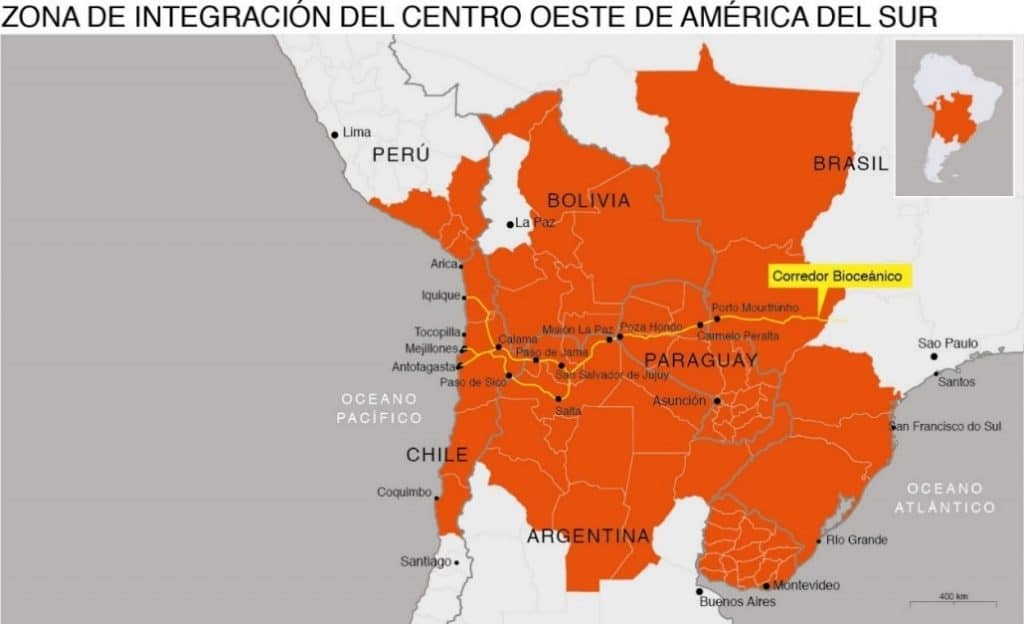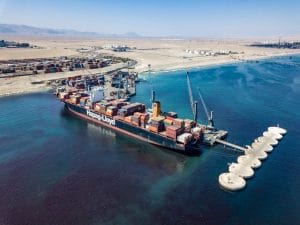Adán Cubillo Hurtado | 12/05/2022
This ambitious project was created with the aim of linking the productive heart of South America with roads, railways, airports and ports, which connect from the coast of Brazil, crossing the territories of Paraguay and Argentina until reaching the ports of northern Chile. With this infrastructure, and the expediting of customs procedures, the aim is to facilitate cross-border traffic, achieving high logistics efficiency, greater economic competitiveness and more effective regional integration.
On December 21, 2015, the governments of Brazil, Chile, Argentina and Paraguay signed the ‘Asunción Declaration’, a starting point for a large transportation project called the ‘Bi-Oceanic Corridor’. In this first agreement, the four regions agreed to enhance large transnational infrastructures (roads, bridges, railways and tunnels), while also coordinating measures that facilitate the traffic of people and goods. These objectives were established with the creation of a working group that was set up to seek the benefits of reciprocal facilities that could improve the competitiveness of the region’s products in the Asia-Pacific and European markets. “In general, the instructions as stated in the 2017 ‘Brasilia Declaration’ were seen through to completion, although in some cases not enough progress has been made. For example, the pilot plan to streamline border controls across all four countries was initiated, but not completed, nor have the efforts aimed at integrating computing systems [with standardized data systems and forms] been completed, and joint studies with the private sector to evaluate the functioning of modes of infrastructure and transport are underway,” explains Herman Cortés, researcher at the Regional Institute of Applied Economics (Instituto de Economía Aplicada Regional, IDEAR).
Among the milestones achieved in these seven years, the expert highlights the advances made in the work on unfinished infrastructure – many roads have now been built and are operational – and “the decision, along with financing, to build the bridge over the Paraguay River, which will link the border towns of Porto Murtinho and Carmelo Peralta”, connecting this region with Brazil. “All that is missing is the final connection in Campo Grande, and the paving of a few kilometers in Argentine territory, from the border with Paraguay (Misión La Paz), as well as finishing the highway Ruta 51 from Salta to Paso de Sico, on the border with Chile,” he points out.
Location and impact on the regions
The Bi-Oceanic Corridor is located around the Tropic of Capricorn and passes through the heart of ZICOSUR (Zona de Integración del Centro Oeste de América del Sur [South American Central-West Integration Zone]), composed of provinces of Argentina, states of Brazil, departments of Bolivia and Paraguay, regions of Chile and Peru and Municipalities of Uruguay. Despite its name, it has a design whose central aim, as Professor Cortés explains to us, is “more than just to link the Pacific with the Atlantic, it is about serving the commercial and tourist exchanges across the landlocked areas that make up the South American central-western area, as well as offering its businesspeople direct routes out to ports of the Pacific”, which is a focus for Asia’s main commercial interests.

Infographic by Jorge Cortés G., a partner of ‘Gráfica Interactiva’
Although there was a general willingness for interregional engagement, road infrastructure has historically been a barrier to trade flows between the different countries in the corridor. “The lack of adequate roads has been the main obstacle between the Argentine northwest and the Paraguayan Chaco area, as well as between both regions with the Brazilian southwest, in addition – in the latter case – to the absence of a bridge that would allow crossing of the Paraguay River,” the expert said. By carrying out the reforms projected in the agreement, it will be possible to increase both business between these regions and imports from the Asian market. “The latter, plus some internal exports, could generate more returning freight and prevent trucks or trains from returning empty from Chilean ports. This factor is one of the most expensive ones for transportation, which has been one of the biggest difficulties for South American trade to and from the Pacific,” he says.
Studies that have been conducted so far on the potential effect on the adjacent markets have yielded promising results. In Brazil, several locations in Campo Grande could be transformed into logistics centers for exports to Asia, “as well as the collection and distribution of imports from there and other markets.” In Argentina, “interest has been shown in enabling hubs in the provinces of Jujuy and Salta, while in Chile the greatest benefit lies in taking advantage of the transit of goods, driven by a bi-provincial public-private organization, aiming to diversify production in the area, which until now has basically consisted of mining,” Cortés claims.
In addition to domestic growth, the corridor could generate important value chains between these four countries, such as some cases of mining production between the Argentine northwest with the Chilean regions of Tarapacá and Antofagasta. “In fact, there is already a significant supply of complementary components for the production of lithium, some of whose inputs are imported through ports in Antofagasta. They are transported to the mountain range on the Argentine side and then exported to markets in the Pacific through the same docks. It is anticipated that something similar will happen with substantial copper deposits, which are close to becoming operational in the province of Salta,” the expert predicts.
Another chain – not of production, but of services – will be in the tourism sector, “due to the complementarity of the different regions of the four countries through which this corridor runs. This will be between bordering countries as well as between the players involved. An example of this will be the circuit between the most arid desert in the world (Atacama Desert) and the most humid region on the planet (or at least in the Americas), which is the Pantanal, each offering contrasting landmarks that can be toured in less than a week, as well as other international attractions in the northwest of Argentina and Paraguay,” he says.
Challenges and next steps
 Although, as indicated in the ‘Asunción Declaration’, the corridor is a multinational project, agreed and supported from the outset by the governments of Brazil, Paraguay, Argentina and Chile, the truth is that, as Herman Cortés explains, “the regions through which it passes have, so far, had little participation in its governance.” Since 2021, efforts have been mobilized by subnational governmental authorities and some local universities, who have responded to the call for cooperation. “In contrast, there has been little involvement from the business community. Which, together with the effects of the pandemic, has made for limited progress in commercial and tourism agreements,” factors that could be “the most important mechanism for the effective participation of all the regions involved, especially their community of small and medium-sized enterprises.”
Although, as indicated in the ‘Asunción Declaration’, the corridor is a multinational project, agreed and supported from the outset by the governments of Brazil, Paraguay, Argentina and Chile, the truth is that, as Herman Cortés explains, “the regions through which it passes have, so far, had little participation in its governance.” Since 2021, efforts have been mobilized by subnational governmental authorities and some local universities, who have responded to the call for cooperation. “In contrast, there has been little involvement from the business community. Which, together with the effects of the pandemic, has made for limited progress in commercial and tourism agreements,” factors that could be “the most important mechanism for the effective participation of all the regions involved, especially their community of small and medium-sized enterprises.”
Although advances in infrastructure are taking place as expected, Cortés says that “it will be necessary to have an overall procedure that is standardized as much as possible, with electronic border controls and using modern technologies, for which not only will there need to be agreements between the respective Customs services, phytosanitary controls (for the prevention and control of plant diseases), animal health controls and migration controls, but also adequate telecommunications infrastructures at those border points, which are not currently available. Without that expediting of procedures, we will continue to experience the current difficulties, which cause excessive delays in controls and make transportation services even more expensive due to those hours lost at borders.”
The next steps in terms of construction are, however, fairly straightforward. As regards road infrastructure, the most significant project is starting on the construction of the bridge over the Paraguay River, as well as the completion of the road in the Chaco region of Paraguay. In addition, all four countries must “ensure the provision of fiber optic cabling or other secure means for internet connection, and all telecommunications systems along the Bi-Oceanic Corridor in their respective departments.”
Another factor that is very much being taken into account in the progress of the project is that the original communities that inhabit the territories through which the corridor passes must be respected, “so as to avoid any difficulty that may arise when the expected increase in traffic begins, as it could generate some negative externality, if the appropriate measures are not taken at the right time,” concludes Herman Cortés.
Article Collaborator:
 Herman Cortés graduated as a Journalist from the University of the North [Univeridad del Norte]. Since 2018, he has coordinated the Integration Projects at the Regional Institute of Applied Economics (IDEAR), of the Catholic University of the North [Universidad Católica del Norte, UCN], where he was appointed Associate Professor of the academic body and Researcher of the Economics and Administration Faculty of the UCN.
Herman Cortés graduated as a Journalist from the University of the North [Univeridad del Norte]. Since 2018, he has coordinated the Integration Projects at the Regional Institute of Applied Economics (IDEAR), of the Catholic University of the North [Universidad Católica del Norte, UCN], where he was appointed Associate Professor of the academic body and Researcher of the Economics and Administration Faculty of the UCN.
He was Head of the International Affairs Regional Unit of the Regional Government of Antofagasta (2014-2018) and served as Pro Tempore Secretary of the South American Central-West Integration Zone (ZICOSUR) between 2014 and 2016, which he helped create in 1997. While living for 5 years in Salta, Argentina, he was the first executive secretary of the Interregional Business Group of the South American Central-West (Grupo Empresarial Interregional del Centro Oeste Sudamericano, GEICOS), between 1975 and 1978. He has participated in most of the meetings of the Border Committee (then Integration Committee) between the Norte Grande of Chile and the Argentine Northwest.
He currently has a close relationship and international contacts with the Bi-Oceanic Corridor Highway, which is being driven by the National Governments of Brazil, Paraguay, Argentina and Chile, for access of the South American Central-West area to the Pacific markets, through our border crossings, roads, railways and international ports. He was the Coordinator of the FIC-R [Fondo de Innovación para la Competitividad Regional (Innovation Fund for Regional Competitiveness)] Bi-Oceanic Corridor Project that was executed by IDEAR, of the UCN, and which ended on June 30, 2021.





